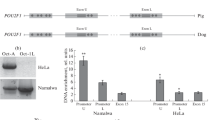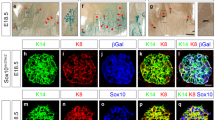Abstract
Oct-2 is a member of the POU family of transcription factors, which specifically bind to the octamer DNA motif ATGCAAAT and its closely related sequences. Unlike its ubiquitous counterpart Oct-1, Oct-2 is thought to be expressed only in B lymphocytes and neuronal cells and is mainly involved in immunoglobulin gene expression. We show here that Oct-2 is also expressed in the epithelial cells of mouse mammary gland, and that this expression is developmentally regulated. Rapid amplification of cDNA ends and subsequent cDNA cloning indicate that the mammary gland expresses multiple Oct-2 isoforms, including a novel isoform, named Oct-2.7. Compared with Oct-2 (isoform 2.1), the deduced Oct-2.7 sequence has an additional 22 amino acids close to the N-terminus and a novel 76-amino-acid C-terminus resulting from alternative splicing, with retention of the last intron that is spliced out in all other isoforms. Although Oct-2.7 has intact POU-specific and POU-homeo domains, it is unable to bind to the octamer motif, unlike all other known isoforms. Like Oct-1, both Oct-2.1 and Oct-2.7 can activate basal β-casein gene promoter activity. However, activation by Oct-2.7, which is independent of DNA binding, is significantly lower than that by Oct-2.1. Moreover, deletion of the first 114 amino acids at the N-terminus of Oct-2.1 has no effect on activation; this does not support previous reports of the presence of an inhibitory domain in this region.







Similar content being viewed by others
References
Ahmad I, Hoessli DC, Walker-Nasir E, Rafik SM, Shakoori AR, Nasir-ud-Din (2006) Oct-2 DNA binding transcription factor: functional consequences of phosphorylation and glycosylation. Nucleic Acids Res 34:175–184
Annweiler A, Zwilling S, Wirth T (1994) Functional differences between the Oct2 transactivation domains determine the transactivation potential of individual Oct2 isoforms. Nucleic Acids Res 22:4250–4258
Chapman CM, Latchman DS (1998) The different alternatively spliced isoforms of the Oct-2 transcription factor repress the involucrin promoter in a cell type-specific manner. Mol Biol Rep 25:253–257
Clerc RG, Corcoran LM, LeBowitz JH, Baltimore D, Sharp PA (1988) The B-cell-specific Oct-2 protein contains POU box- and homeo box-type domains. Genes Dev 2:1570–1581
Corcoran LM, Karvelas M, Nossal GJ, Ye ZS, Jacks T, Baltimore D (1993) Oct-2, although not required for early B-cell development, is critical for later B-cell maturation and for postnatal survival. Genes Dev 7:570–582
Corcoran LM, Koentgen F, Dietrich W, Veale M, Humbert PO (2004) All known in vivo functions of the Oct-2 transcription factor require the C-terminal protein domain. J Immunol 172:2962–2969
Dong B, Zhao F-Q (2007) Involvement of the ubiquitous Oct-1 transcription factor in hormonal induction of beta-casein gene expression. Biochem J 401:57–64
Friedl EM, Matthias P (1995) Transcriptional activation and repression, two properties of the lymphoid-specific transcription factor Oct-2a. Eur J Biochem 234:308–316
Gay RD, Dawson SJ, Latchman DS (1997) The different inhibitory domains of the Oct-2 transcription factor have distinct functional activities. FEBS Lett 416:135–138
Goldsborough AS, Healy LE, Copeland NG, Gilbert DJ, Jenkins NA, Willison KR, Ashworth A (1993) Cloning, chromosomal localization and expression pattern of the POU domain gene Oct-11. Nucleic Acids Res 21:127–134
Hatzopoulos AK, Stoykova AS, Erselius JR, Goulding M, Neuman T, Gruss P (1990) Structure and expression of the mouse Oct2a and Oct2b, two differentially spliced products of the same gene. Development 109:349–362
Inamoto S, Segil N, Pan ZQ, Kimura M, Roeder RG (1997) The cyclin-dependent kinase-activating kinase (CAK) assembly factor, MAT1, targets and enhances CAK activity on the POU domains of octamer transcription factors. J Biol Chem 272:29852–29858
Laemmli UK (1970) Cleavage of structural proteins during the assembly of the head of bacteriophage T4. Nature 277:680–685
Latchman DS (1996) The Oct-2 transcription factor. Int J Biochem Cell Biol 28:1081–1083
Latchman DS (1999) POU family transcription factors in the nervous system. J Cell Physiol 179:126–133
Lillycrop KA, Latchman DS (1992) Alternative splicing of the Oct-2 transcription factor RNA is differentially regulated in neuronal cells and B cells and results in protein isoforms with opposite effects on the activity of octamer/TAATGARAT-containing promoters. J Biol Chem 267:24960–24965
Lillycrop KA, Latchman DS (1995) The inhibitory domain in the Oct-2 transcription factor represses gene activity in a cell type-specific and promoter-independent manner. Mol Biol Rep 21:87–94
Lillycrop KA, Dawson SJ, Estridge JK, Gerster T, Matthias P, Latchman DS (1994) Repression of a Herpes simplex virus immediate-early promoter by the Oct-2 transcription factor is dependent on an inhibitory region at the N terminus of the protein. Mol Cell Biol 14:7633–7642
Liu YZ, Lillycrop KA, Latchman DS (1995) Regulated splicing of the Oct-2 transcription factor RNA in neuronal cells. Neurosci Lett 183:8–12
Meijer D, Graus A, Kraay R, Langeveld A, Mulder MP, Grosveld G (1990) The octamer binding factor Oct6: cDNA cloning and expression in early embryonic cells. Nucleic Acids Res 18:7357–7365
Muller-Immergluck MM, Schaffner W, Matthias P (1991) Transcription factor Oct-2A contains functionally redundant activating domains and works selectively from a promoter but not from a remote enhancer position in non-lymphoid (HeLa) cells. EMBO J 9:1625–1634
Prefontaine GG, Walther R, Giffin W, Lemieux ME, Pope L, Hache RJ (1999) Selective binding of steroid hormone receptors to octamer transcription factors determines transcriptional synergism at the mouse mammary tumor virus promoter. J Biol Chem 274:26713–26719
Rijnkels M, Wheeler DA, de Boer HA, Pieper FR (1997) Structure and expression of the mouse casein gene locus. Mamm Genome 8:9–15
Rosner MH, Vigano MA, Ozato K, Timmons PM, Poirier F, Rigby PW, Staudt LM (1990) A POU-domain transcription factor in early stem cells and germ cells of the mammalian embryo. Nature 345:686–692
Scholer HR (1991) Octamania: the POU factors in murine development. Trends Genet 7:323–329
Scholer HR, Hatzopoulos AK, Balling R, Suzuki N, Gruss P (1989) A family of octamer-specific proteins present during mouse embryogenesis: evidence for germline-specific expression of an Oct factor. EMBO J 8:2543–2550
Schonemann MD, Ryan AK, Erkman L, McEvilly RJ, Bermingham J, Rosenfeld MG (1998) POU domain factors in neural development. Adv Exp Med Biol 449:39–53
Schreiber E, Matthias P, Muller MM, Schaffner W (1989) Rapid detection of octamer binding proteins with “mini-extracts”, prepared from a small number of cells. Nucleic Acids Res 17:6419
Schubart K, Massa S, Schubart D, Corcoran LM, Rolink AG, Matthias P (2001) B cell development and immunoglobulin gene transcription in the absence of Oct-2 and OBF-1. Nat Immunol 2:69–74
Sharif MN, Radomska HS, Miller DM, Eckhardt LA (2001) Unique function for carboxyl-terminal domain of Oct-2 in Ig-secreting cells. J Immunol 167:4421–4429
Sturm RA, Das G, Herr W (1988) The ubiquitous octamer-binding protein Oct-1 contains a POU domain with a homeo box subdomain. Genes Dev 2:1582–1599
Veenstra GJ, van der Vliet PC, Destree OH (1997) POU domain transcription factors in embryonic development. Mol Biol Rep 24:139–155
Verrijzer CP, van der Vliet PC (1993) POU domain transcription factors. Biochim Biophys Acta 1173:1–21
Verrijzer CP, Alkema MJ, van Weperen WW, van Leeuwen HC, Strating MJ, van der Vliet PC (1992a) The DNA binding specificity of the bipartite POU domain and its subdomains. EMBO J 11:4993–5003
Verrijzer CP, Oosterhout JA van, Vliet PC van der (1992b) The Oct-1 POU domain mediates interactions between Oct-1 and other POU proteins. Mol Cell Biol 12:542–551
Wirth T, Priess A, Annweiler A, Zwilling S, Oeler B (1991) Multiple Oct2 isoforms are generated by alternative splicing. Nucleic Acids Res 19:43–51
Zhao F-Q, Adachi K, Oka T (2002) Involvement of Oct-1 in transcriptional regulation of beta-casein gene expression in mouse mammary gland. Biochim Biophys Acta 1577:27–37
Zhao F-Q, Zheng Y, Dong B, Oka T (2004) Cloning, genomic organization, expression, and effect on beta-casein promoter activity of a novel isoform of the mouse Oct-1 transcription factor. Gene 326:175–187
Acknowledgements
We thank the staff at the Vermont Cancer Center DNA Analysis Facility for DNA sequencing services.
Author information
Authors and Affiliations
Corresponding author
Additional information
This work was supported by Vermont Cancer Center and the University of Vermont Agricultural Experimental Station.
The nucleotide sequence of the novel Oct-2 isoform 2.7 reported in this paper has been submitted to GenBank with assigned accession number AY746974.
Rights and permissions
About this article
Cite this article
Dong, B., Zhao, FQ. Expression of the Oct-2 transcription factor in mouse mammary gland and cloning and characterization of a novel Oct-2 isoform. Cell Tissue Res 328, 595–606 (2007). https://doi.org/10.1007/s00441-006-0368-0
Received:
Accepted:
Published:
Issue Date:
DOI: https://doi.org/10.1007/s00441-006-0368-0




